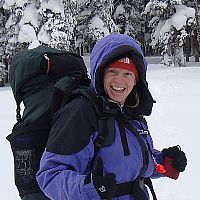Nelson & Kurc, 2010
Continuous Monitoring of Dynamic Pulse-Driven Phenological Phases in a Semiarid Shrubland.
Nelson, K., Kurc, S.A. (2010)
AGU Fall Meeting (Poster) Abstract B23G-0468.
-
Catalina-Jemez, GRAD STUDENT
-
Catalina-Jemez, INVESTIGATOR
Abstract
An advanced onset of spring phenology has been well documented in the literature, generally citing increasing springtime temperatures as the primary cause. Importantly, a majority of these studies have been conducted in ecosystems where energy is the major limiting factor to growth. Lacking are studies in semiarid or arid ecosystems that cover over a third of the Earth’s land surface, where water is the major limiting factor. Climate change will inevitably affect energy- and water-limited systems differently; therefore, understanding the mechanisms controlling phenology in both systems is imperative. Phenology in semiarid or arid ecosystems is particularly sensitive to precipitation inputs delivered as discrete pulses. Most of these precipitation events are small (e.g. < 5 mm), wetting only the top few centimeters of the soil and then quickly lost to evapotranspiration. Only rare large precipitation events (e.g. > 10 mm) are capable of wetting the root zone beyond the depth of evaporative demand and becoming available for plant phenological activity. Global climate models are generally predicting changes in the interannual variability of precipitation, with semiarid areas worldwide projected to experience changes in the timing, frequency, and magnitude of precipitation. If these changes impact timing and location of plant available water, what will be the effect on the phenological activity of these pulse-dominated ecosystems? The objective of this study is to understand triggers of phenological activity in an expansive shrubland ecosystem of the southwestern United States. We present results from three years of daily micro-meteorological and phenological data collected from a creosote-bush dominated shrubland site within the Santa Rita Experimental Range, southern Arizona. Our site is equipped with an eddy covariance tower providing estimates of ecosystem-scale water and carbon fluxes and associated micro-meteorological variables including precipitation and soil moisture at multiple depths. Additionally, three phenology cameras (i.e. pheno-cams) distributed within the footprint of the eddy provide a daily record of phenology. We show that spring phenological events (flowering and green-up) are consistent and tend to be associated with an energy trigger, whereas summer phenological events (repeat flowering and repeat green-up) are more dependent on the timing and amount of monsoon precipitation. Additionally, our study demonstrates the high value in continuous monitoring of phenological events alongside micro-meteorological instruments.
Citation
Nelson, K., Kurc, S.A. (2010): Continuous Monitoring of Dynamic Pulse-Driven Phenological Phases in a Semiarid Shrubland . AGU Fall Meeting (Poster) Abstract B23G-0468..
Explore Further


